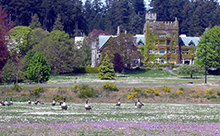Oral tradition and archaeological evidence around Esquimalt Lagoon and Coburg Peninsula indicate that First Nations have used the lagoon for food gathering, habitation and spiritual purposes for thousands of years. Prior to European contact, the intertidal clam beds at the entrance to the lagoon were extensively harvested by ancestors of the Esquimalt and Songhees First Nations. Other abundant resources were fish, birds, mammals and other riches of the surrounding forest lands. Today shellfish harvesting is prohibited due to contamination.
The Esquimalt Harbour and Coburg Peninsula became more developed starting in 1854 with the establishment of a naval base and firing range. Following the gold rush of 1858 in BC’s interior, a large influx of settlers to the lagoon area led to the established of several farms and a saw mill, later replaced by a tannery.
 In 1902, James Dunsmuir, a politician and coal baron, purchased a large portion of land to the west of the lagoon, and built a castle and gardens known as Hatley Park. In 1940, 20 years after the death of Dunsmuir, the federal government bought the land and established a military college, later known as Royal Roads Military College. The military continued to use Coburg Peninsula as a rifle range, and a degaussing station was also built on the spit (a degaussing range tests the build-up of magnetic field on ships’ hulls.). In 1994, the military college closed, and Royal Roads University was established at Hatley Park in 1995.
In 1902, James Dunsmuir, a politician and coal baron, purchased a large portion of land to the west of the lagoon, and built a castle and gardens known as Hatley Park. In 1940, 20 years after the death of Dunsmuir, the federal government bought the land and established a military college, later known as Royal Roads Military College. The military continued to use Coburg Peninsula as a rifle range, and a degaussing station was also built on the spit (a degaussing range tests the build-up of magnetic field on ships’ hulls.). In 1994, the military college closed, and Royal Roads University was established at Hatley Park in 1995.
Many historical activities had known or possible environmental impacts on Esquimalt Lagoon including: logging; construction of various shoreline structures; dumping of waste; military training exercises; farming and ornamental gardens which introduced fertilizers and invasive species; residential and recreational land use with its associated pollution.
Today, Ocean Boulevard runs the length of Coburg Peninsula, and is extensively used for commuting, recreation and as an emergency route. The abutments supporting the lagoon bridge have undergone severe erosion during storm events in recent years, resulting in major repair costs. This is expected to worsen with rising sea levels and climate change. The area remains a popular recreation destination and visitors. People enjoy walking, exercising their dogs, picnicking, wildlife viewing and sun bathing along the sand spit and kayaking and fishing in the lagoon.
A federally designated Migratory Bird Sanctuary encompasses the lagoon and adjacent lands within 100 metres of the high water mark. This sanctuary is managed by the Canadian Wildlife Service. Pets are required to be on a leash within the Migratory Bird Sanctuary.